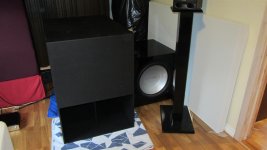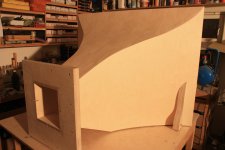And I prefer a smooth stereo reproduction over both! 😀I've tried it both ways and every way in between and must say I strongly prefer the smooth, enveloping action as opposed to a peaky stereo reproduction. YMMV.
i'm not sure that a machine gun or a stopwatch are producing anything close to a clean sinewave and that hearing them is because both these sources are broader in frequency content than a simple pure fundamental, indeed the timing of these "impulse" like events are at a low frequency but i don't think we hear them as 5 or 6 hz tones.
Exactly right- there isn't a good example of a 5hz sine wave that people have heard- because people don't hear 5hz.
Earthquake motion is closest thing that some of us would have experienced.
Take it as an insult if you will, but it wasn't meant that way. I wasn't the one that said my wife would laugh at the results. I saw that as an insult directed at the OP. Maybe you should have asked about the specifics instead of judging before knowing those specifics.
I remember in earlier talks we had on impulse response and phase where you quickly dismissed the results and audibility. Lately you seem to have changed your mind on that. Maybe you should not judge everything on sight.
What about impulse response are we talking about? That they should be clean and tight and all have a positive rising edge that is time aligned between all drivers to produce a right triangle step response as the ideal? Ideal being transient perfect. Transient perfect is indeed audible and makes a big difference between hearing a speaker play a performance and being teleported to the live performance.
Pano - so you don't buy Griesinger's claim that bass envelopment involves a multiplicity of signals arriving from random directions? He seems to have studied this problem a lot and that is his conclusion. Doesn't jib with your claim. But I guess that you are saying that you don't like "envelopment" - although that is a major criteria for a good concert hall.
In which paper does Griesinger make specific claim about bass envelopment?
We can hear below .01 Hz.
However, our bodies have various resonances around 10-5 Hz which overwhelm our hearing sensation. Also there is not much meaningful sound below 40 Hz.
Turk, I am curious.
How did your audiologist test the test apparatus to be sure it was able to test that low?
i will see him in February. i'll get the specifics as to the equipment he has at his office and report back.
.01 would that not be infrasonic? and from what little i know most published info agrees with the conventional 20 hz lower limit.
Last edited:
For those of us (me) with mature ears, the octave from 20 to 40 Hz contains fundamental notes far more musically "meaningful" than the harmonics in the octave from 10kHz to 20kHz.We can hear below .01 Hz.
However, our bodies have various resonances around 10-5 Hz which overwhelm our hearing sensation. Also there is not much meaningful sound below 40 Hz.
That said, unless one designs for sub 40 Hz response, the harmonic distortion in typical systems will inform us of the (mostly) missing fundamentals.
In which paper does Griesinger make specific claim about bass envelopment?
You know I just don't recall. He did a lot of work on this and found that incoherent responses at the two ears was best. He described this as being random waves from many directions, which, of course, is exactly what bass in a large room does.
I'm running multiple subwoofers in my home theater. I recently went from a 18" sealed subwoofer to a 15" front loaded horn. Both placed at the rear of the room and crossed over at 50 Hz. Frequency response more or less identicial after turning the mouth of the horn towards the corner. I didn't expect much difference, especially considering the low Xover, but the difference was very audible in my subjective test.
Attachments
Art - the old trick of the missing fundamental.
Yea, over 10 kHz is just not very interesting to me, but not because of age, its always been that way.
Yea, over 10 kHz is just not very interesting to me, but not because of age, its always been that way.
That is how Waves Maxxbass works. I see Behringer is including it in power amps!. How strange. Everytime Uli Behringer does something cool, I wind up defending his products. Now he includes built in distortion in power amps. I still have all my hair, so I give up being a Uli Behringer apologist.For those of us (me) with mature ears, the octave from 20 to 40 Hz contains fundamental notes far more musically "meaningful" than the harmonics in the octave from 10kHz to 20kHz.
That said, unless one designs for sub 40 Hz response, the harmonic distortion in typical systems will inform us of the (mostly) missing fundamentals.
.01 hz LOL, a cycle every 100 seconds - 🙂 Hold on a minute... it will be here in a minute
Imagine you are measuring bearing load on a fan that pushes air out of a long train tunnel.
They complain that the measurements are high one minute and low maybe two minutes later. The tunnel operators were sure it was a problem with the measurement system rather than asking if it matched the quarter wavelength of the tunnel.
Theese things happen in real life.
Never thought of a train tunnel as a long resonator with 1 minute modes. Cool. Open ended tunnel will be half wave though?
Imagine you are measuring bearing load on a fan that pushes air out of a long train tunnel.
They complain that the measurements are high one minute and low maybe two minutes later. The tunnel operators were sure it was a problem with the measurement system rather than asking if it matched the quarter wavelength of the tunnel.
Theese things happen in real life.
And they said that they could hear that?
Just the change in fan/bearing noise . . . possibly . . .And they said that they could hear that?
But I bet we've all heard/felt the lf resonance of a car cabin with a window (part) open . . .
Gedlee - Not saying it could be heard. Just saying a clean tone of really really low frequency can exist .
xrk871- I think the fan source was closer to the middle or close so I am not sure how the distances work. Total tunnel length is about 6 miles.
xrk871- I think the fan source was closer to the middle or close so I am not sure how the distances work. Total tunnel length is about 6 miles.
If ends are open then boundary condition is open-open or 1/2-wave, fan excitation can be in middle, still works. 6 miles = 12,070m line length or 0.014Hz half-wave frequency (or cycle is about 71 seconds!). It would just show up as a 71 second cyclic variation in the blower fan efficiency. If the fan has some broadband noise at 71 second period then it could couple and amplify. A train going through the tunnel would certainly be a good broadband noise source.
But I bet we've all heard/felt the lf resonance of a car cabin with a window (part) open . . .
Which is way up about 30 Hz or so, not .01 Hz. That's 3000 times higher in frequency.
My opinion is that horn works really well when they have controlled directivity in a broader frequency range. I would say CD to 700-600 Hz is about the minimum for a really good result. Lower is obviously better but requires size than many don't have in their home.
And large voice coil compression drivers are much better than the smaller ones. The high frequency is not an issue with a 1.5" throat diameter.
Attached is a midbass horn we're working on. CD down to 250 Hz. It's pretty big.
And large voice coil compression drivers are much better than the smaller ones. The high frequency is not an issue with a 1.5" throat diameter.
Attached is a midbass horn we're working on. CD down to 250 Hz. It's pretty big.
Attachments
- Status
- Not open for further replies.
- Home
- Loudspeakers
- Multi-Way
- Audibility of distortion in horns!

